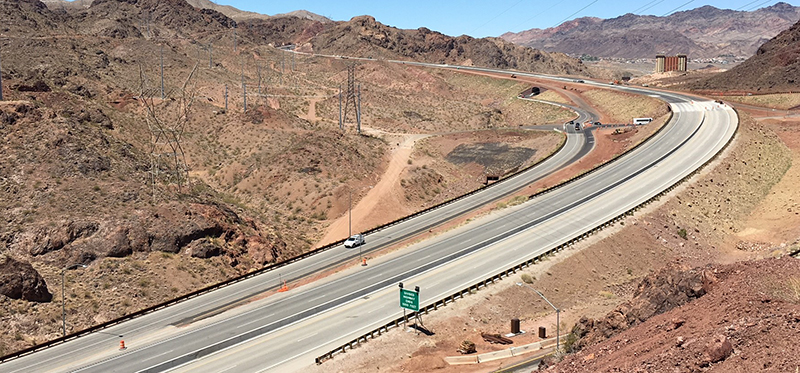
Seventy years after the start of the nation’s interstate program, another vital piece of highway was completed in 2018. Using Fuel Revenue Indexing (FRI) and federal funds, the $318 million project has a 2.5-mile section constructed in PCC (Phase I) and a 12.5-mile stretch constructed with asphalt (Phase II).
The U.S. Congress designated this freeway as I-11 in the “Moving Ahead for Progress in the 21st Century” Act (MAP-21). Phase I has been managed by the Nevada Department of Transportation, while the 12.5-mile stretch (Phase II) was a design-build contract awarded to Las Vegas Paving and administered by the Regional Transportation Commission (RTC) of Southern Nevada.
The more complicated Phase II included extensive rock excavations, eleven bridges and a scenic view parking area overlooking Lake Mead. Four overpasses and one large underpass were constructed as wildlife crossings for area tortoise, coyotes and bighorn sheep. Construction started in the spring of 2015. Massive cuts were blasted through the Eldorado Mountains to connect this road to the impressive Mike O’Callahan/Pat Tillman Memorial Bridge across the Colorado River. This new 15-mile stretch of Interstate I-11 will eventually connect Las Vegas with Phoenix and become part of the NAFTA and CANMEX trade corridors.
The design was done in-house by Las Vegas Paving, assisted by CA Group. RTC contracted Jacobs Engineering Group to be the program manager. The year- long design process was completed in 60, 90 and 100 percent increments by February 2016. Thirty percent of the grading work was already completed while the design was ongoing. A maximum grade of six percent was specified, so two miles of climbing lanes were added. Massive cuts through the Eldorado Mountains, with a total of 5.5 million yards of blasting, removal of six million yards of dirt and rock and construction of 11 bridges were needed to prepare for the road’s construction.
To accommodate the future traffic of 17,000 vehicles per hour, the alignment is two lanes wide in each direction with a 4-foot inside shoulder and a 12-foot wide outside shoulder, for a total pavement width of 40 feet in each direction.
The structural section was determined to require 16 inches of Type 1-B aggregate base, and 9 inches of NDOT Type 2C coarse mix containing 15 percent RAP. The shoulders are 16-inch aggregate base with 6 inch of the same Type 2C mix. Some 550,000 tons of aggregate base was needed. The 350,000 tons of 3/4 of an inch mix was produced with NDOT’s specified PG 76-22NV binder in an on-site portable mixing plant of 400 tons per hour capacity. The binder was supplied by Southwest Liquid Asphalt and Emulsions, a new subsidiary of Las Vegas Paving Corporation. The 5-bin mix received the 100 percent crushed aggregates from several sources, mainly from the Lone Mountain and Apex quarries.
As usual in Nevada, the DOT performed the Hveem mix design, which later in production is fine-tuned based on air voids, density and Hveem stability. NDOT’s mix design had an optimum binder content (OBC) of 3.6 percent + 0.6 percent binder replacement for a total of 4.2 percent binder. In production, this was lowered to 3.9 percent. Lime marination with 1.25 percent lime resulted in a TSR value of 98 percent.
The project specifications required a minimum density of 93 percent of Maximum Theoretical Specific Gravity (Gmm). Hveem stabilities in mix design ranged from 48 to 52 and the VMA came in at 14.3 percent. The field compaction based on nuclear gauge readings of 4.3 percent air voids was excellent and well within spec. The final lift of 1-inch open-graded mix with PG 76-22NV required 30,000 tons produced at the Sunset Plant in Henderson, Nevada.
The bridges were all constructed cast-in-place by Las Vegas Paving. Only the electrical, DMS signs, cameras and Intelligent Transportation System (ITS) were outsourced. For dust suppression, one million gallons of treated waste water was used daily. The quality of workmanship was apparent, seeing Brian Marchello (a second-generation paving foreman with Las Vegas Paving) demonstrating to a new crew member how to rake and construct a perfect transfer joint, and then also taking the time to discuss the details.
Paving started daily at 5:00 a.m., with 10 to 12 hour shifts in typical temperatures of 120°F. To show you how serious the population of Nevada is about having good roads, this project and many others in Nevada were (partially) funded by a new three-year extension of the “Fuel Revenue Index”, basically an extra local fuel tax for transportation projects. This is one of the few new highways being constructed in the nation.
It was an interesting and complex project, delivered well within spec and on time. And as stated by the Assistant Project Manager, Steven Ireland; “It was nice for once to construct a new road without being in live traffic.” This new section of interstate was officially opened in August of 2018.
What is Fuel Revenue Indexing?
Fuel Revenue Indexing (FRI) funds are generated each time a motorist fuels their vehicle. A portion of every gallon of gas purchased in Clark County, Nevada is funding transportation projects in Southern Nevada.
Humer is an Asphalt Institute Senior Regional Engineer based in California.













